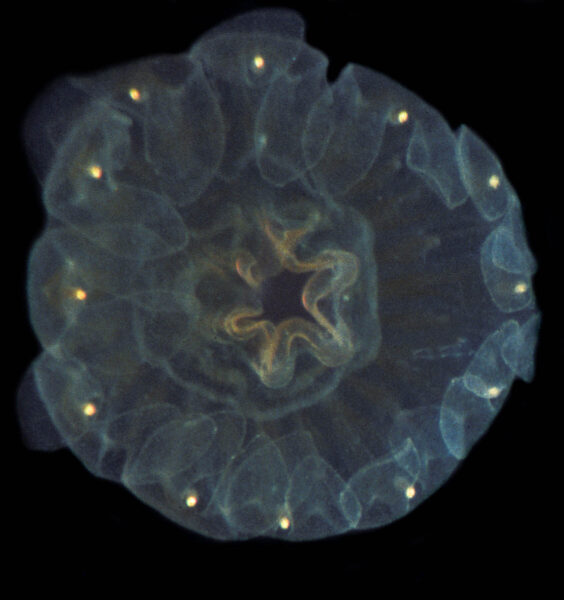Jellyfish
Order: Semaeostomeae
Jellyfish are floating animals with gelatinous, umbrella-shaped bells and stinging tentacles.
This section shows one large critter image at a time. Use the thumbnails that follow to select a specific image to display here.

This gallery contains a grid of small thumbnails. Selecting a thumbnail will change the main image in the preceding section.
Appearance
Three species of jellyfish can be found in the Chesapeake Bay:
- Sea nettles, Chrysaora chesapeakei
- Moon jellyfish or common jellyfish Aurelia aurita
- Lion’s mane jellyfish, Cyanea capillata
Jellyfish have a transparent, gelatinous body and an umbrella-shaped bell called a medusa. Tentacles with stinging cells hang from the bell. The stinging cells are called nematocysts. Sea nettles have a smooth, milky white bell that grows to about 4 inches in diameter. Up to 24 tentacles hang from under the bell.
The moon jellyfish is the Bay’s largest jellyfish. It can grow 10 to 12 inches in diameter. Hundreds of short tentacles hang like fringe from the bell’s edge. The lion’s mane jellyfish has a broad, flattened bell and eight clusters of short tentacles. The bell is usually orange-brown and grows to about the same size as the sea nettle.
Feeding
Sea nettles and lion’s mane jellyfish prey upon fish, shrimp, comb jellies and other small creatures. They use their stinging tentacles to entangle, paralyze and capture their prey. Each stinging cell is like a barb that injects venom into its prey. Jellyfish then use their tentacles to move the food into their mouth, which is located under the center of the bell. Moon jellyfish eat plankton, including mollusks, crustaceans and copepods.
Predators
Many larger species, including fish, crustaceans and sea turtles, eat sea nettles.
Reproduction and life cycle
Sea nettles spawn in mid-summer. They die after spawning. Males release sperm into the water. Females’ eggs are fertilized as they swim and pump water through their body. After fertilization, eggs develop into tiny, free-swimming larvae called planulae, which the female releases into the water.
Larvae float with the currents for a few days, then settle and attach to a firm surface. The larvae blossom into anemone-like polyps that bud and grow over the winter. By spring, the polyps develop tiny, floating medusae that are layered on top of one another. The medusae are eventually released into the water. The freely floating medusae (called ephyra) eventually grow tentacles and mature into adults.
Did you know?
- Jellyfish are macrozooplankton, the largest of the Bay’s planktonic animals.
- Jellyfish propel themselves through the water by rhythmically expanding and contracting their bells. However, they are not very good swimmers; jellyfish are mostly transported by wind and currents.
- Sea nettles are nearly 90 percent water.
- Wear a wet suit or pantyhose when swimming to avoid receiving a painful jellyfish sting.
Sources and additional information
- Life in the Chesapeake Bay by Alice Jane Lippson and Robert L. Lippson
- Chesapeake Bay: Nature of the Estuary, A Field Guide by Christopher P. White
- Forecasting Sea Nettles – NOAA Chesapeake Bay Office
- Jellyfish of the Chesapeake – Maryland Sea Grant
- Animal Diversity Web: Aurelia aurita and Cyanea capillata – University of Michigan Museum of Zoology
